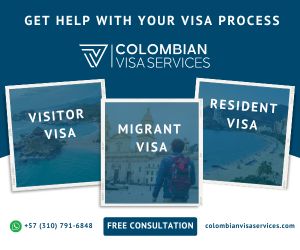Guide to Residency in Colombia
Summary: How to get residency in Colombia. A Guide for Expats, Retirees and Immigrants in Colombia.
Obtaining a residency visa in Colombia is not always easy, but our Guide to Residency in Colombia gives newcomers an overview of the steps involved and advice from others who have already navigated the process.
- Research Visa Types
- Visit the official website of the Colombian Ministry of Foreign Affairs to understand different visa types: Visa Requirements.
- Choose the appropriate visa category that suits your purpose of stay, such as work, student, retirement, or investment visa.
- Prepare Required Documents
- Gather personal documents such as passport, birth certificate, and marriage certificate (if applicable).
- Obtain a police clearance certificate from your home country.
- Get any necessary documents officially translated into Spanish if they are not already in Spanish.
- Some visas may require additional documents, such as proof of income for a retirement visa or a job offer for a work visa.
- Apply for a Colombian Visa
- Complete the online visa application form on the official website: Online Visa Application.
- Upload the required documents in the online system.
- Pay the visa application fee, which varies depending on the type of visa.
- Schedule an appointment at the nearest Colombian consulate if required.
- Attend the visa interview with all the original documents if necessary.
- Register Your Visa
- Once your visa is approved, you must register it at a Migración Colombia office within 15 days of arriving in Colombia or receiving the visa if you are already in the country.
- Visit the Migración Colombia website for office locations: Migración Colombia.
- Apply for a Colombian ID Card (Cédula de Extranjería)
- After registering your visa, apply for a Cédula de Extranjería at a Migración Colombia office within 15 days of registering your visa.
- Fill out the application form and pay the associated fee.
- Provide fingerprints and a photograph for the ID card.
- Apply for a Tax Number (RUT - Registro Único Tributario)
- Visit the DIAN (Dirección de Impuestos y Aduanas Nacionales) website to create a RUT: DIAN.
- Complete the RUT application form (Formulario 001).
- Submit the form along with a copy of your Cédula de Extranjería at a DIAN office.
- Wait for the RUT to be processed and issued.
- Open a Bank Account
- Choose a Colombian bank that suits your needs.
- Visit a branch with your passport, visa, Cédula de Extranjería, and RUT.
- Fill out the necessary application forms and provide any additional documentation required by the bank.
- Stay Informed About Visa Renewal and Residency Requirements
- Keep track of the expiration date of your visa and start the renewal process well in advance.
- Check the Ministry of Foreign Affairs website regularly for any changes in visa policies or residency requirements.
What tips do expats have about residency and visas in Colombia?
"The first step in obtaining a visa for Colombia is to determine the appropriate visa category for the intended stay. Generally, tourists and business travelers require a tourist visa or a business visa. Depending on nationality and the University attended, students may require a student visa. Visitors with longer stays may require a temporary residence visa. Once the category is chosen and associated requirements are met, an appointment must be made at a Colombian embassy or consulate for visa processing. Residency applications in Colombia are done through the National Immigration Agency (Instituto Colombiano de Migración). To begin the process, it is necessary to ensure all required documents and fees are prepared, and that the right type of visa is obtained. The documents required to apply for permanent residency vary depending on the nationality of the applicant and the intended length of stay in Colombia. Once all documents have been prepared, they must be presented to the National Immigration Agency, which will review them and then authorize the residency. If a favorable decision is made, the applicant is then issued a visa that allows them to stay in the country indefinitely. The applicant is then expected to register the visa in a local police station near their residence, and then obtain an ID card at the local immigration office," commented one member living in Colombia.
"The laws changed in December, 2017 and many of the visas, including retirement and investment visas are now for 3 years instead of 1 as they were before. Check local websites as this new information is updated," mentioned one expat living in Colombia.
About the Author
 Joshua Wood, LPC joined Expat Exchange in 2000 and serves as one of its Co-Presidents. He is also one of the Founders of Digital Nomad Exchange. Prior to Expat Exchange, Joshua worked for NBC Cable (MSNBC and CNBC
Primetime). Joshua has a BA from Syracuse and a Master's in Clinical and Counseling Psychology from Fairleigh Dickinson University. Mr. Wood is also a licensed counselor and psychotherapist.
Joshua Wood, LPC joined Expat Exchange in 2000 and serves as one of its Co-Presidents. He is also one of the Founders of Digital Nomad Exchange. Prior to Expat Exchange, Joshua worked for NBC Cable (MSNBC and CNBC
Primetime). Joshua has a BA from Syracuse and a Master's in Clinical and Counseling Psychology from Fairleigh Dickinson University. Mr. Wood is also a licensed counselor and psychotherapist.
Some of Joshua's articles include Pros and Cons of Living in Portugal, 10 Best Places to Live in Ireland and Pros and Cons of Living in Uruguay. Connect with Joshua on LinkedIn.
Additional Information:
- Colombia Guide
- Healthcare & Health Insurance in Colombia
- Members Talk about Healthcare & Health Insurance in Colombia
- Best Places to Live in Colombia
- Real Estate in Colombia
- Guide to Real Estate in Colombia
- Pros & Cons of Living in Colombia
- Cost of Living in Colombia
- How to Enroll in the Public Healthcare System in Colombia
- 10 Best Places for Families to Live in Colombia
- How to Get a Driver's License in Colombia
- 15 Best Places to Live in Colombia
- 2025 Guide to Living in Colombia
- Pros and Cons of Living in Colombia 2025
- 2025 Guide to Moving to Colombia





